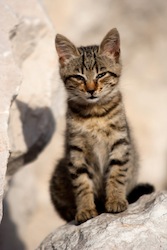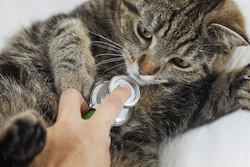Coryza (the cat disease)
 The Coryza of the cat is a disease highly contagious. Several pathogens are the cause of this pathology : The viruses belong to the families of the Herpesvirus, with Calicivirus and of Reovirus.
The Coryza of the cat is a disease highly contagious. Several pathogens are the cause of this pathology : The viruses belong to the families of the Herpesvirus, with Calicivirus and of Reovirus.
Bacteria may also be involved in the disease as Staphylococcus, Streptococcus, Bordetella bronchiseptica and Pasteurella multocida and Chlamydia psittaci, which is a "Rickettsia".
Presentation
The incubation period of the disease is 2 to 4 days (delay between the moment where the cat is contaminated and the moment when the first symptoms appear).
A cat infected with coryza can excrete the pathogen for several months (Calicivirus, Chlamydia psittaci including), that increases the contagion to its congeners. Furthermore, the calicivirus is very resistant in the external environment !
As for typhus, disease can be transmitted indirectly, unless your cat has no access to the outside !
Symptoms
A cat reaches coryza may present :
– Rhinitis manifested by sneezing and "nose which flows". If rhinitis is very important, It can present difficulty breathing.
– A cough
– Conjunctivitis : red eyes with more or less thick secretions. Sometimes the eyes can be fully glued.
– inflammation of the tongue accompanying sometimes ulcers. The cat will then drool and have difficulty feeding.
– Of the fever
– One lymph node reaction
Treatment
Your veterinarian will prescribe, as the case :
– Of antibiotics to avoid secondary bacterial infections
– Of the L - lysine (amino acid that helps stimulate immunity following a viral disease, including infection by herpes simplex virus)
– One anti-viral serum
– A cleaner eye and one eye drops antibiotic to treat conjunctivitis
– To treat rhinitis, inhalation sessions (aerosol therapy) are sometimes necessary.
These sessions can be made in Veterinary Clinic with a nebulizer or possibly carried out at home, putting the cat in its transport case : Place the bowl of inhalation before the grid, outside the body, and it covers all of a damp towel. In the bowl of inhalation several drugs are associated and paid in boiling water. Your veterinarian will prescribe an antibiotic association, of drugs to thin nasal secretions and possibly a bronchodilator.
In some cases, and especially if the animal does not feed, the cat will be hospitalized and put under perfusion.
Evolution and prognosis
 The evolution of this disease varies from one cat to another :
The evolution of this disease varies from one cat to another :
A complete healing may occur in 8 to 10 days after the establishment of the treatment, but many complications may also occur !
The main complications that occur are :
– complications eye
– complications pulmonary (pneumonia)
– one chronic inflammation of the mouth (Stomatitis) causing big problems for food
– one rhinitis and chronic sinusitis with sometimes a destruction of the nasal turbinates
Coryza can even result in the death of the animal, especially in kittens or immunocompromised subjects.
Furthermore, a cat has contracted the disease can remain bearer herpesvirus and calicivirus throughout his life. Viruses can indeed remain latent in the body and reappear during stress or a State of fatigue. Where the importance of avoiding any contamination with the vaccine !
Vaccination
Before the age of 6 weeks, the kitten is protected by maternal antibodies.
The vaccine may be made at the age of 6 weeks but the primary vaccination occurs in practice most often at 8 weeks of age, with a reminder 3 to 4 weeks after. Your veterinarian will then recall a year later, then each year. Syears annual vaccination reminder, the antibody levels decreased and falls below the threshold of protection.
§
Coryza is a common disease. It can often take a chronic form and cause symptoms during the lifetime of the cat… A simple vaccine is sufficient to protect your pet, so think about it !
